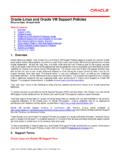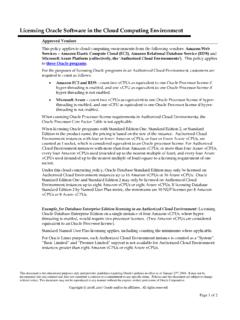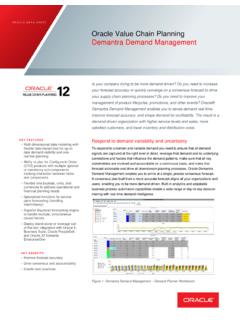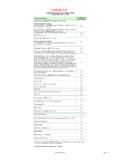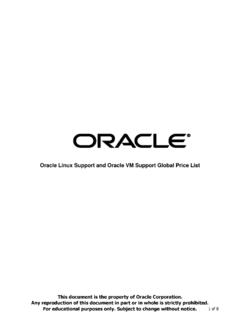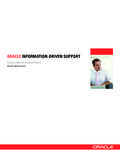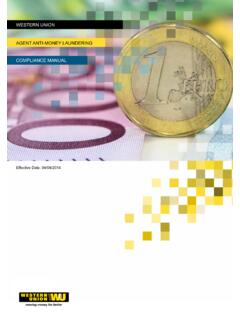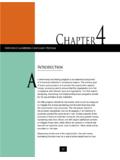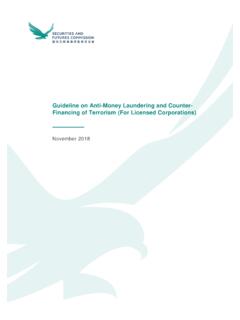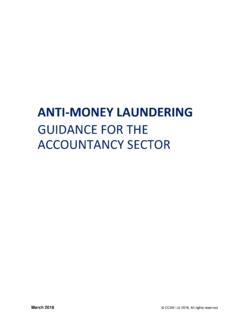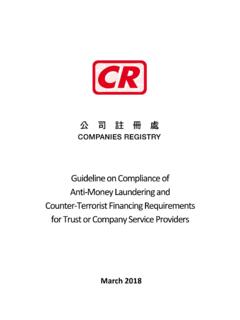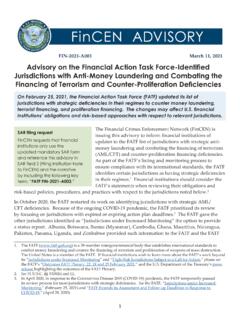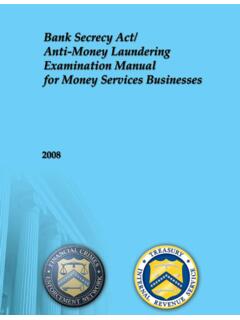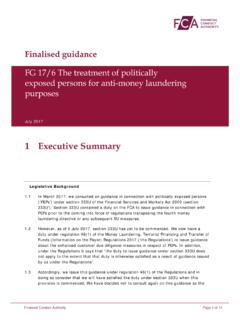Transcription of Trade-Based Money Laundering - Oracle
1 Trade-Based Money Laundering A Comprehensive Approach to Combat TBML 1 Trade-Based Money Laundering : A COMPREHENSIVE APPROACH TO COMBAT TBML Table of Contents Introduction to Trade Finance The Basics 2 Introduction to TBML The Basics 2 Key Challenges in Enforcing a TBML Program 3 Setting an Appropriate TBML Program Covering the Entire Spectrum of Risks Involved 5 TBML Controls and Specific Solution Requirements 7 Review KYC / CDD Profile through Complete Deal Underwriting 7 Name and Payment Screening 8 AML Transaction Monitoring 9 The Use of Data Analytics to Identify TBML 9 The Evolution
2 Of TBML Monitoring in Banks 10 2 Trade-Based Money Laundering : A COMPREHENSIVE APPROACH TO COMBAT TBML When used by the wrong people, Trade Finance can be one of the most effective and dangerous methods for Money Laundering and international movement of illicit funds. Introduction to Trade Finance The Basics Trade Finance is the financing for trade activity in both domestic and international markets. A trade transaction requires a seller of goods and services as well as a buyer.
3 Various intermediaries such as banks and other financial institutions can facilitate these transactions by financing the trade. Trade Finance includes activities such as lending, issuing letters of credit, factoring, export credit and insurance. Companies involved with trade finance include importers and exporters, banks and financiers, insurers and export credit agencies, and other service providers such as tax agents, lawyers, trade mediators, etc. Certain forms of trade finance were specifically crafted to supplement traditional financing.
4 Repayment terms relating to trade finance activities are generally short-term, with the majority being used solely for the completion of a particular business transaction. When used for legitimate purposes, this financing option forms a safety net, helping to protect the interests of buyers and sellers in the international marketplace and assisting in the completion of transactions that may involve multiple currencies, geographies and parties. When used by the wrong people, however, Trade Finance can be one of the most effective and dangerous methods for Money Laundering and international movement of illicit funds.
5 Trade-Based Money Laundering (further referred to as TBML ) is the process by which criminals use a legitimate trade to disguise their criminal proceeds from unscrupulous sources. The crime involves a number of schemes in order to complicate the documentation of legitimate trade transactions; such actions may include moving illicit goods, falsifying documents, misrepresenting financial transactions, and under- or over-invoicing the value of goods. The strategy report of the International Narcotics Control Board shows that through TBML schemes, criminals launder hundreds of billions of dollars annually.
6 Additionally, the US Department of Treasury, in its National Anti- Money Laundering Risk Assessment, stated that TBML can have a more destructive impact on legitimate commerce than any other form of Money Laundering activity. Introduction to TBML The Basics TBML has become a widely used term, covering a broad spectrum of services and products, including those referred to as Trade Finance. In reality, the majority of international trade is carried out under Open Account terms, under which, unless the financial institution is providing credit facilities, the financial institution s involvement will be limited to the actual payment Money transfer, and it will not generally be aware of the underlying reason for the payment.
7 In such a case, the financial institution does not have the ability to execute anything other than the standard AML Transaction Monitoring and Sanctions Screening on the final payment that was sent (such as the case with a Funnel Account ). However, in the case where the financial institution provides any sort of Credit Facilities in relation to the trade, there are several other opportunities to better understand the business rationale, the risk involved, and the movements of funds. 3 Trade-Based Money Laundering : A COMPREHENSIVE APPROACH TO COMBAT TBML Trade Finance is a document-centric process involving numerous contracts, product descriptions, brochures, bids, shipping manifests, invoices, etc.
8 In some cases, the terms and conditions, as well as side agreements, may not be documented in writing or disclosed to the bank. Due to this fact and using existing technology, the process is heavily dependent on human review and manual screening, and highly reliant on the experience of the individual banker. In its right form, the TBML program should include complete deal underwriting as part of the KYC and CDD effort, proper screening of all parties involved, the detection of suspicious transactional activity across current and deposit accounts, and finally payment screening for sanctions.
9 We will further discuss best practices and the proper implementation of each of these contact points later in this paper. Indeed, banks are the central clearinghouse for all financial transactions pertaining to Trade Finance. They have access to the complete documentation and profiles of their customers, and are therefore best placed to govern Trade Finance activities. Thus, it is no surprise that regulators and other law enforcement agencies have shifted their focus to banks in an effort to clamp down on TBML.
10 However, regardless of how good the banks are positioned to tackle TBML, the multitude of challenges they face may sometimes debilitate the effort or even dissuade the entire process. Trade Finance is a document-centric process (involving numerous contracts, product descriptions, brochures, bids, shipping manifests, invoices, etc.) and in some cases the terms and conditions, as well as side agreements (which may be essential to understand the true nature of the business transaction), may not be documented in writing or disclosed to the bank.
